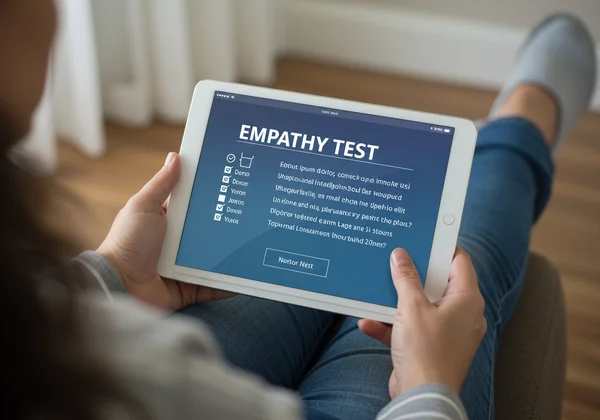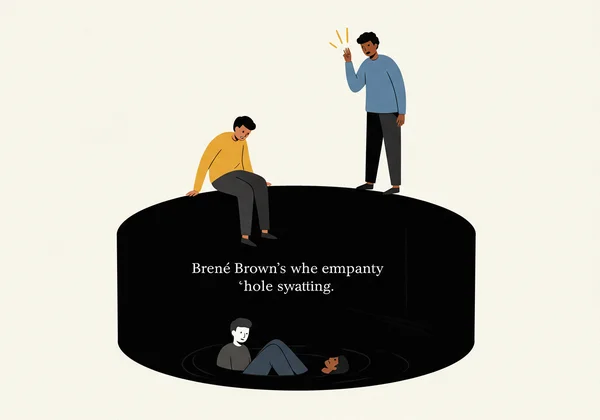Empathy Test: Understanding Empathy vs. Sympathy vs. Compassion
Have you ever felt confused by the words empathy, sympathy, and compassion? These terms are often used as if they mean the same thing, but their differences are vital for building strong connections and navigating our social world. Understanding them is a cornerstone of emotional intelligence. But how do I know if I'm empathetic? This guide will clarify these concepts, and a great first step to understanding your own emotional landscape is to take a comprehensive empathy test. By the end, you'll see how mastering this emotional vocabulary can transform your relationships. You can discover your empathy score to get started.

Understanding Empathy: Stepping into Another's Shoes
At its core, empathy is the ability to understand and share the feelings of another person. It's not about feeling sorry for someone; it's about trying to feel with them. Think of it as putting on their glasses to see the world from their perspective, even for a moment. Psychologists often break empathy down into distinct types, helping us better define empathy and its role in our lives.

Cognitive Empathy: The "Head" Connection
This is the intellectual side of empathy. It’s the ability to understand someone else's emotional state and what they might be thinking. For example, if a coworker is stressed about a deadline, cognitive empathy allows you to recognize their anxiety and understand the reasons behind it without necessarily feeling that stress yourself. This type of emotional understanding is crucial for effective communication and negotiation.
Emotional Empathy: Feeling What They Feel
Also known as affective empathy, this is the component that most people think of when they hear "empathy." It's the capacity to share the feelings of another person, creating a genuine emotional connection. When a friend shares news of a loss and you feel a pang of sadness for them, you are experiencing emotional empathy. It's a powerful force for bonding but can also lead to emotional burnout if not managed with good self-awareness.
Compassionate Empathy (Empathic Concern): The Drive to Act
This is where understanding and feeling merge into action. Compassionate empathy goes beyond just knowing or sharing another's feelings; it moves you to help if you can. You see someone struggling, you feel their distress, and you're motivated to offer support, whether it's a helping hand or a listening ear. This is the most active form of empathy and is fundamental to building supportive interpersonal relationships.
Sympathy Explained: Feeling For, Not With
Here is where the crucial distinction in the empathy vs sympathy debate lies. Sympathy is feeling sorrow or pity for someone else's misfortune. It creates a sense of separation—you are on the outside looking in. While empathy says, "I feel with you," sympathy says, "I feel for you." It acknowledges the other person's suffering but from a distance.
The Core Differences from Empathy
The primary difference is perspective. Empathy is about sharing a perspective, while sympathy is about observing it. Brené Brown famously illustrated this with an animation: empathy is climbing down into a dark hole to sit with someone, while sympathy is peering down from the top and shouting, "It's bad down there, huh?" Sympathy can sometimes feel condescending, whereas empathy fosters a genuine connection and validates the other person's feelings. If you're curious about your natural tendencies, an online empathy quiz can offer valuable insights.

When Sympathy is Appropriate (and When It's Not)
Sympathy isn't inherently bad; it has its place. Sending a sympathy card or expressing condolences are common and appropriate social rituals. It shows you care and acknowledge a person's hardship. However, in deeply personal or vulnerable moments, leading with empathy is almost always more powerful. Relying only on sympathy can create distance and prevent the formation of a truly supportive bond.
Compassion: Moving from Understanding to Action
If empathy is feeling with someone and sympathy is feeling for them, compassion is the desire to alleviate their suffering. It is inherently action-oriented. The sympathy vs compassion difference is that compassion is an active response, while sympathy can remain passive. It’s the engine that drives us to act on our empathetic feelings.

The Relationship Between Empathy, Sympathy, and Compassion
Think of these three concepts as a progression. Empathy allows you to understand and feel what another is going through. This feeling might lead to sympathy, where you acknowledge their pain. But compassion is the next step: it takes the shared feeling from empathy and channels it into a desire to help. You can feel empathy without being compassionate, but it's difficult to be truly compassionate without some level of empathy.
Why Compassion Drives Meaningful Connection
Compassion is the ultimate relationship-builder. When you act compassionately, you are demonstrating to someone that they are not alone and that you are willing to invest your energy in their well-being. This creates profound trust and safety. It moves beyond words and into the realm of tangible support, which is often what people need most when they are struggling. This active care is a key component of high emotional intelligence.
Why This Distinction Boosts Your Emotional Intelligence
Understanding the nuances between these terms is more than just a vocabulary lesson; it’s a practical tool for personal growth. Having clear emotional intelligence definitions helps you identify your feelings and respond to others more effectively. This skill enhances every aspect of your life, from your closest relationships to your professional interactions. Ready to see where you stand? A free empathy test is a great place to start.

Improving Communication and Relationships
When you can accurately identify whether a situation calls for empathy, sympathy, or compassion, you can respond in a way that truly supports the other person. Instead of offering hollow platitudes (sympathy), you can offer genuine understanding (empathy) or practical help (compassion). This deepens trust and makes your friends, family, and colleagues feel seen and valued, which is essential for improving communication.
Navigating Complex Social Situations More Effectively
In the workplace, a leader who understands these differences can foster a more supportive and productive team. They can use cognitive empathy to understand a team member's perspective during a disagreement and compassionate empathy to offer support during a personal crisis. This emotional dexterity allows for navigating social situations with grace and skill, preventing misunderstandings and building a positive environment. An empathy test for adults can reveal strengths and opportunities for growth in these areas.
Master Your Emotional Vocabulary for Deeper Connections
Empathy, sympathy, and compassion are distinct tools in your emotional toolkit. Empathy connects us by sharing a feeling. Sympathy acknowledges feeling from a distance. Compassion transforms feeling into action. Knowing when and how to use each one empowers you to build stronger, more meaningful relationships in every corner of your life.
The first step to mastering these skills is understanding your own natural tendencies. Are you more inclined to cognitive or emotional empathy? How does this influence your interactions? Ready to uncover your unique emotional profile? Our scientifically designed assessment can provide the clarity you need. Take our empathy test today to discover your unique score and receive personalized insights for growth.
Frequently Asked Questions About Empathy, Sympathy, and Compassion
Can you have empathy without sympathy?
Yes, absolutely. You can use cognitive empathy to understand someone's situation (e.g., a rival's business failure) without feeling sorry for them. Empathy is about understanding and sharing a feeling, which doesn't always have to be a positive or supportive one.
Which is better: empathy or compassion?
Neither is "better"; they serve different functions. Empathy is the foundation for connection, while compassion is the catalyst for helping. The most effective response often involves both: using empathy to connect and then using compassion to take supportive action. Both are vital for strong emotional intelligence.
How can I tell if I'm expressing empathy or sympathy?
Pay attention to your internal feeling and your language. If you feel a sense of pity and are "looking down" on their problem, it's likely sympathy (e.g., "Oh, you poor thing."). If you feel a shared emotional response and are trying to connect with their experience, it's empathy (e.g., "That sounds incredibly difficult.").
Is there a way to assess my own level of empathy?
Yes, a well-designed empathy quiz can help you understand your emotional profile. Our comprehensive online empathy assessment tool is based on psychological principles to help you measure your cognitive and emotional empathy. We encourage you to find out your score and begin your journey toward greater self-awareness.